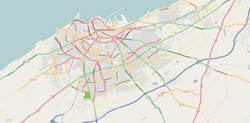Anfa
|
Anfa أنفا ⴰⵏⴼⴰ |
|
|---|---|
| District of Casablanca | |
| Location in Greater Casablanca | |
| Coordinates: 33°35′18″N 7°38′31″W / 33.58833°N 7.64194°WCoordinates: 33°35′18″N 7°38′31″W / 33.58833°N 7.64194°W | |
| Country |
|
| Region | Casablanca-Settat |
| Area | |
| • Total | 37.5 km2 (14.5 sq mi) |
| Population (2004) | |
| • Total | 492,787 |
| Time zone | WET (UTC+0) |
| • Summer (DST) | WEST (UTC+1) |
Anfa (Berber: Anfa (ⴰⵏⴼⴰ); Arabic: أنفا) was the ancient toponym for Casablanca during the classical period. The city was founded by Berbers around the 10th century BC, with the Romans under Augustus later establishing the commercial port of "Anfus" in 15 BC. Anfus is now the name of a district in the oldest part of Casablanca, located in the Casablanca-Settat region of Morocco. The district covers an area of 37.5 square kilometres (14.5 square miles), and as of 2004 had 492,787 inhabitants.
The area which is today Casablanca was founded and settled by the Berbers by about the 10th century BC. It was used as a port by the Phoenicians and later by the Romans.
Romans occupied the area in 15 BC and created a commercial port under Augustus, directly connected to the Mogador island in the Iles Purpuraires of southern Mauritania. From there they obtained a special dye, that colored the purple stripe in Imperial Roman Senatorial togas. The expedition of Juba II to discover the Canary islands and Madeira probably departed from Anfa.
Anfa est une grande cité, edifiée par les Romans sur le rivage de la mer Oceane... (Leo Africanus: Anfa is a big city, built by the Romans on the ocean shore...) [1]
The Roman port, probably called Anfus, was part of a Berber client state of Rome until Emperor Augustus. When Rome annexed Ptolemy of Mauretania's kingdom, Anfa was incorporated into the Roman Empire by Caligula. But this was done only nominally because the Roman limes was a few dozen kilometers north of the port (the Roman military fortifications of Mauretania Tingitana were just a few kilometers south of the Roman colonia named Sala Colonia). However, Roman Anfa—connected mainly by commerce and by socio-cultural ties to Volubilis ("autonomous" from Rome since 285 AD)—lasted until the 5th century, when Vandals conquered Roman northwestern Africa.
...
Wikipedia

